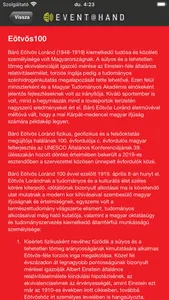MAGYAR:
Báró Eötvös Loránd (1848-1919) kiemelkedő tudósa és közéleti személyisége volt Magyarországnak. A súlyos és a tehetetlen tömeg ekvivalenciáját igazoló mérése az Einstein-féle általános relativitáselmélet, torziós ingája pedig a tudományos szénhidrogénkutatás megalapozását tette lehetővé. Ezen felül miniszterként és a Magyar Tudományos Akadémia elnökeként jelentős fejlesztéseknek volt az irányítója. Kiváló sportember is volt, mind a hegymászás mind a lovasportok területén nagyszerű eredményeket ért el. Báró Eötvös Loránd életművével méltóvá vált, hogy a mai Kárpát-medencei magyar ifjúság számára példakép legyen.
Báró Eötvös Loránd fizikus, geofizikus és a felsőoktatás megújítója halálának 100. évfordulója c. évfordulós magyar felterjesztés az UNESCO Általános Konferenciájának 39. ülésszakán hozott döntés értelmében bekerült a 2019-es esztendőben a szervezettel közösen ünnepelt évfordulók közé.
ENGLISH:
Hungarian scientist Eötvös Loránd (Roland, baron von Eötvös) is remembered today largely for his work on gravitation and surface tension, and the invention of the torsion pendulum. The Eötvös experiment (a famous physics experiment that measured the correlation between inertial mass and gravitational mass, demonstrating that the two were one and the same, something that had long been suspected but never demonstrated with the same accuracy), the Eötvös torsion balance („pendulum”, a geophysical prospecting instrument, the Eötvös number (a dimensionless number measuring the importance of gravitational forces compared to surface tension forces), the Eötvös parameter (a parameter derived from the gravitational and inertial masses), the Eötvös effect (i.e. the change in perceived gravitational force caused by the change in centrifugal acceleration resulting from eastbound or westbound velocity), the Eötvös rule (enabling the prediction of the surface tension of an arbitrary liquid pure substance), the Eötvös physical unit (unit of acceleration divided by distance in the centimeter-gram-second system of units), the Eötvös Loránd University, the Loránd Eötvös Mathematics Competition, the Eötvös peak in the Dolomites, the mineral lorándite ,and the Eötvös crater on the moon are named after him.
One of his main achievements was the Eötvös pendulum, which is a sensitive instrument for measuring the density of underlying rock strata. The device measures not only the direction of force of gravity, but the change in the force of gravity's extent in the horizontal plane. It determines the distribution of masses in the Earth's crust. The Eötvös torsion balance, an important instrument of geodesy and geophysics throughout the world, studies the Earth's physical properties. It is used for mine exploration, and also in the search for minerals, such as oil, coal and ores. The Eötvös pendulum was never patented, but after the demonstration of its accuracy and numerous visits to Hungary from abroad, several instruments were exported worldwide, and the richest oilfields in the United States were discovered by using it. The Eötvös pendulum was used to prove the equivalence of the inertial mass and the gravitational mass accurately, as a response to the offer of a prize. This equivalence was used later by Albert Einstein in setting out the theory of general relativity.
Báró Eötvös Loránd (1848-1919) kiemelkedő tudósa és közéleti személyisége volt Magyarországnak. A súlyos és a tehetetlen tömeg ekvivalenciáját igazoló mérése az Einstein-féle általános relativitáselmélet, torziós ingája pedig a tudományos szénhidrogénkutatás megalapozását tette lehetővé. Ezen felül miniszterként és a Magyar Tudományos Akadémia elnökeként jelentős fejlesztéseknek volt az irányítója. Kiváló sportember is volt, mind a hegymászás mind a lovasportok területén nagyszerű eredményeket ért el. Báró Eötvös Loránd életművével méltóvá vált, hogy a mai Kárpát-medencei magyar ifjúság számára példakép legyen.
Báró Eötvös Loránd fizikus, geofizikus és a felsőoktatás megújítója halálának 100. évfordulója c. évfordulós magyar felterjesztés az UNESCO Általános Konferenciájának 39. ülésszakán hozott döntés értelmében bekerült a 2019-es esztendőben a szervezettel közösen ünnepelt évfordulók közé.
ENGLISH:
Hungarian scientist Eötvös Loránd (Roland, baron von Eötvös) is remembered today largely for his work on gravitation and surface tension, and the invention of the torsion pendulum. The Eötvös experiment (a famous physics experiment that measured the correlation between inertial mass and gravitational mass, demonstrating that the two were one and the same, something that had long been suspected but never demonstrated with the same accuracy), the Eötvös torsion balance („pendulum”, a geophysical prospecting instrument, the Eötvös number (a dimensionless number measuring the importance of gravitational forces compared to surface tension forces), the Eötvös parameter (a parameter derived from the gravitational and inertial masses), the Eötvös effect (i.e. the change in perceived gravitational force caused by the change in centrifugal acceleration resulting from eastbound or westbound velocity), the Eötvös rule (enabling the prediction of the surface tension of an arbitrary liquid pure substance), the Eötvös physical unit (unit of acceleration divided by distance in the centimeter-gram-second system of units), the Eötvös Loránd University, the Loránd Eötvös Mathematics Competition, the Eötvös peak in the Dolomites, the mineral lorándite ,and the Eötvös crater on the moon are named after him.
One of his main achievements was the Eötvös pendulum, which is a sensitive instrument for measuring the density of underlying rock strata. The device measures not only the direction of force of gravity, but the change in the force of gravity's extent in the horizontal plane. It determines the distribution of masses in the Earth's crust. The Eötvös torsion balance, an important instrument of geodesy and geophysics throughout the world, studies the Earth's physical properties. It is used for mine exploration, and also in the search for minerals, such as oil, coal and ores. The Eötvös pendulum was never patented, but after the demonstration of its accuracy and numerous visits to Hungary from abroad, several instruments were exported worldwide, and the richest oilfields in the United States were discovered by using it. The Eötvös pendulum was used to prove the equivalence of the inertial mass and the gravitational mass accurately, as a response to the offer of a prize. This equivalence was used later by Albert Einstein in setting out the theory of general relativity.
Show More







